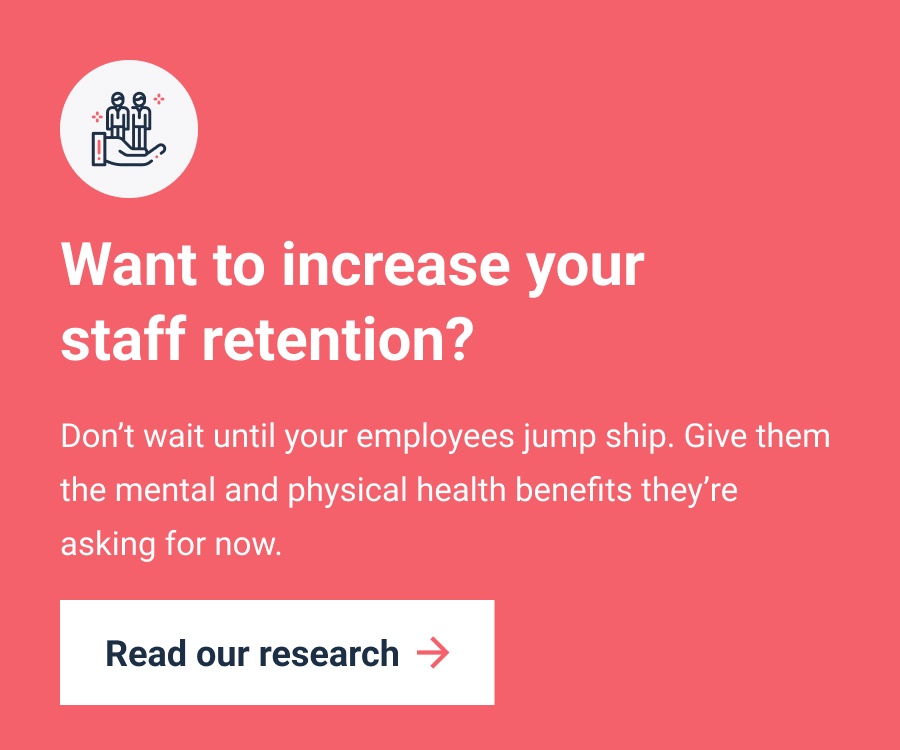Almost half of organisations in the UK still lack a formal health and wellbeing strategy.
It should be no surprise, then, to hear that 80 percent of employees are not engaged or are actively disengaged at work.
Where employers did invest in employees’ physical and mental health, it resulted in 52% better employee morale and engagement. That’s a valuable boost for all businesses, whatever their size
So a wellbeing strategy is worth it. But deploying a successful wellbeing strategy requires more than just offering a weekly yoga class. Instead, it requires a holistic approach to wellness. One that addresses individual needs to maximise the employee experience and drive engagement.
Here are six wellbeing strategy examples to help you re-engage your teams.
1. Create culture norms that support your wellbeing strategy
Some wellbeing strategies address the physical, emotional, mental, and social wellbeing of each employee. These often fail, however, because they lack cultural support, including support for people who don't have English as a first language.
Fortunately, one positive change to come out of the last few years is the normalisation of mental health discussions at work. Companies like Rolls Royce, for example, are building wellbeing strategies centred around employee discussion and involvement. As Chief Medical Officer, David Roomes, explains for the Financial Times, the Rolls Royce 'live well' programme "requires every company site around the world to run a wellbeing committee."
You need to integrate wellbeing strategies into everyday working culture to drive success. Normalising conversations around mental and physical health is key. Failing to do so leaves individuals suffering in silence, leading to increased absence, presenteeism and staff turnover. As David continues to explain, "Those divisions which perform best around wellbeing also have fewer safety concerns and higher staff engagement."
2. Introduce a health and wellbeing allowance
A gym membership is good, but it's not good enough. A strong wellbeing strategy includes a dedicated budget that each employee can use for any membership, class, facility, program, support, or activity. The important point is individuals have autonomy over how they spend this money.
For example, the dating app, Hinge, offers employees a $200 monthly stipend to spend on dates. Eventbrite offers a $60 monthly wellness stipend. And Deloitte offers employees an annual wellbeing subsidy of $500.
Whatever it may be, a health and wellness allowance is an excellent way to support individual needs. And this in turn engages team members and drives happiness at work.
3. Personalise your wellbeing strategy
Wellbeing comes in all shapes and sizes. Some employers offer flexible and remote working hours. Others offer a vibrant office culture and employee discounts.
Regardless, personalisation is the missing link between wellbeing and engagement. Workplace wellbeing apps like Symbio, for example, offer employees a personalised and autonomous way to manage their mental and physical health at work.
Accenture is a great example of a company offering personalised wellbeing. Their high-tech app, Accenture Active, serves 35,000 of their 50,000 North American employees and incorporates various incentives that drive engagement.
Digital mental and physical wellbeing apps like this are becoming more common in the workplace. And if implemented correctly, they're a great way to create engagement and, in turn, increase productivity.
4. Incorporate "stay" interviews
You’ve probably heard of the exit interview. When an employee resigns, these interviews uncover pain points in the employee experience.
But why wait until it's too late?
Instead, have your HR team introduce "stay" interviews into their schedules. These open-forum conversations are a great way to identify intrinsic motivations and uncover what keeps teams interested. They're also a way for employees to feel heard and suggest improvements to the employee experience.
Crucially, stay interviews highlight turnover triggers and help you address issues before they hit that trigger point. These can be things like low or unequal pay, problems with lack of development or inconsistencies in the company culture.
5. Introduce paid volunteer days
According to McKinsey, millennials will make up 75 percent of the global workforce in 2025. Millennials actively seek employers who allow them to volunteer. They want to be part of an organisation that has values and a mission to help the world. To them, it’s not just a job. Who they work for represents who they are.
So, when creating a wellbeing strategy, be sure to create opportunities for this majority demographic (and everyone else) to make an impact in their communities.
Salesforce for example, offer teams paid time off for volunteering. And, according to their employees, this approach to philanthropy is something that "creates greater engagement with our employees and greater impact within our communities."
6. Empower your line managers
The success of a wellbeing strategy depends almost entirely on line managers. Team leads like this play a critical role in supporting "boots-on-the-ground" staff to cope with everyday pressures. Ultimately, it's up to these managers to show up and promote happiness and balance every day.
The pay-off for the business is huge, too. According to research from Saïd Business School, employees are 13 percent more productive when happy. And as we all know, a productive company is a profitable one.
As Cary Cooper, a professor of organisational psychology at Manchester University, explains in the Financial Times, "It's all about the line manager. They need to have interpersonal, social and empathetic skills. In the world we are going to, there has to be a parity of people skills and technical skills for managers."
Finally, be sure to listen to your employees
Poor mental health is the primary reason employees are considering leaving work in the UK in 2025
A strong wellbeing strategy is no longer a 'nice to have'. Today, it is a core business need, and it must address the elephant in the corporate room: employee engagement.
But, a strong wellbeing strategy has to come from the bottom up. It requires leadership teams to hear employees' concerns. What's more, leaders must also act on these concerns and devise ways to improve the employee experience.
As Culture Amp, the market-leading employee experience platform, explains:
"The best way to build an exceptional employee experience is to listen to your employees."
Only then can you begin to address engagement concerns. And only then can you begin to build a culture that promotes positive mental and physical health.
To find out more about Symbio and how we can help with mental and physical wellbeing in the workplace, contact us today.






